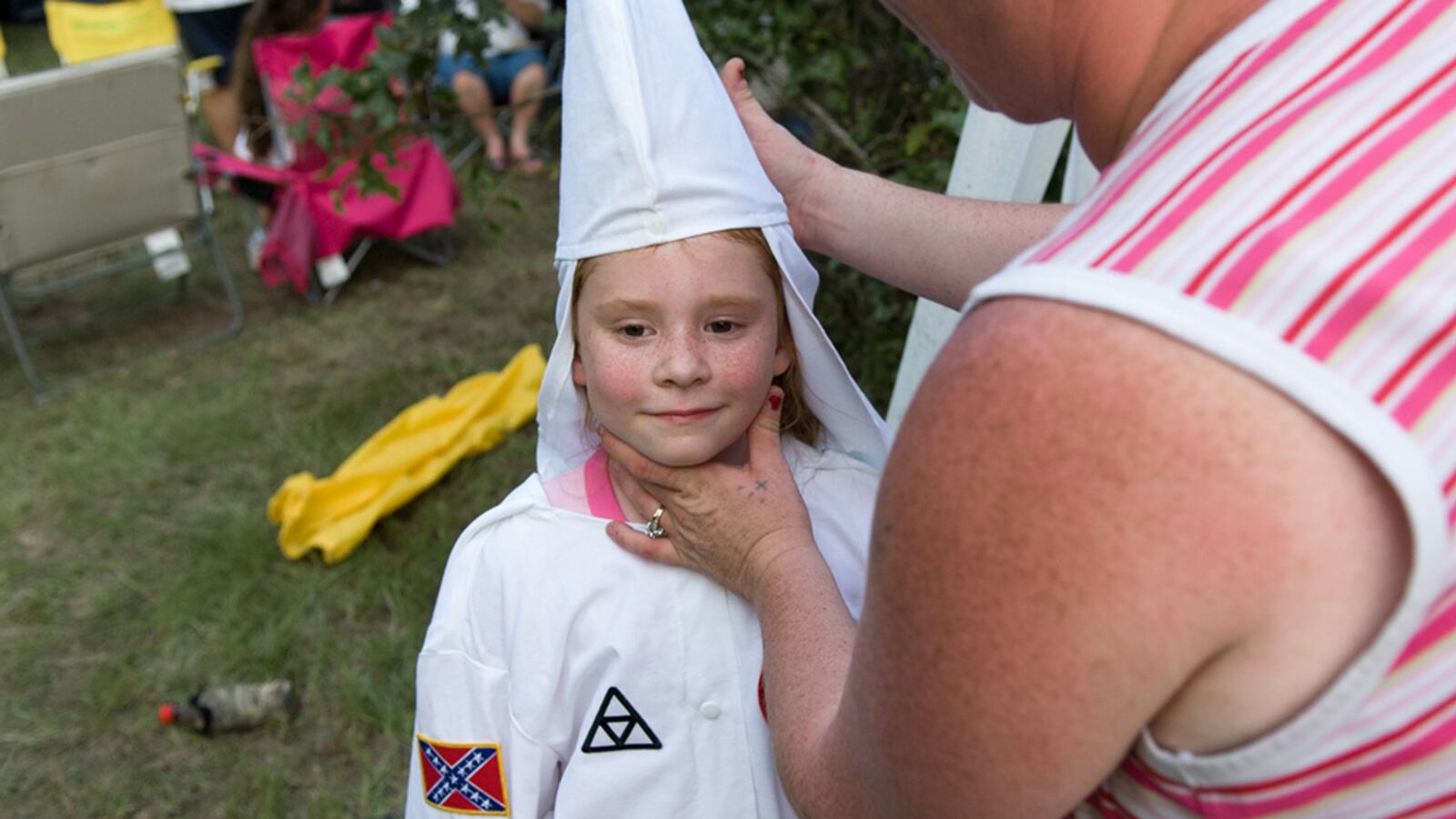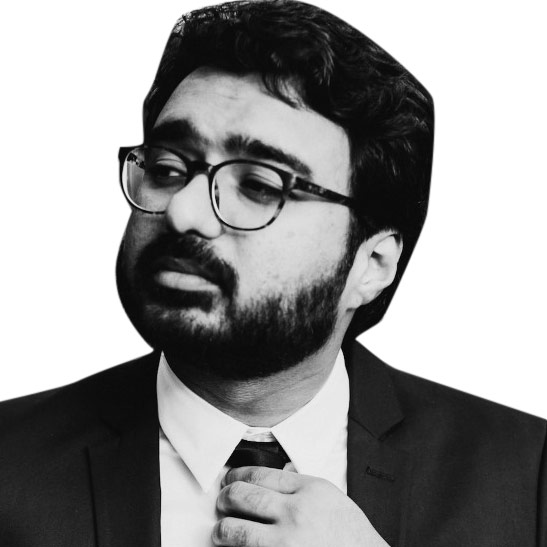On June 10, 1966, three Klansmen murdered Ben Chester White, a 67-year-old African-American farmhand, in Homochitto National Forest, southwestern Mississippi. They had kidnapped White from the nearby town of Natchez, shot him at least 18 times, and thrown his body off of a bridge into the creek below. The FBI believed that the wanton killing was part of a plot to attract Martin Luther King Jr. to Natchez, where the Klan hoped to assassinate him too.
Almost 50 years later, photographer Anthony Karen was standing on the bridge in Homochitto. FBI documents that he had obtained through Freedom of Information Act requests corroborated that this was indeed the site of White’s murder, though Karen could not be certain which bank of the 10-foot-wide creek his body had washed up on to be discovered by a picnicking family in 1966. But there was one cruel lead: the carcass of a poached deer, caught on the right bank.

Ken Parker, a former Nazi and Klansman in the process of taking a \"before\" photo prior to laser tattoo removal treatment—a large swastika and Mioak (Klan blood drop cross) on his chest and a third racially themed tattoo on his shin. Nearly one year ago, Ken Parker joined hundreds of other white nationalists at a Unite the Right rally in Charlottesville, Virginia. In the past 12 months, his beliefs and path have been radically changed by the people he has met since the violent clash of white nationalists and counter protesters led to the death of Heather Heyer, 32. Parker was still weighing those doubts when he saw an African-American neighbor having a cookout near the pool of his apartment complex. As the sun set and the crowd thinned, Parker and his then-girlfriend approached the man, William McKinnon III, a pastor at All Saints Holiness Church. Parker didn’t know McKinnon was a pastor at first, but says he knew there was something different about him. “They sat down,” McKinnon recalls, “and she said they had some questions for me, and I just asked them what were some of the questions that they had.” They kept talking, and then decided to meet up for more discussion. Soon after, McKinnon invited Parker to the church’s Easter service. And on April 17, 2018 — six years after he joined the Klan and just seven months after Charlottesville — Parker decided he’d had enough.
Courtesy Anthony S. KarenThe 53-year-old Karen’s journey to Homochitto was part of his larger collection of work on the white power movement. Since 2005, he has been photographing hate groups across the United States, from Klansmen in Kentucky to Nazis in Pennsylvania. Unwilling to be cast as a propagandist, he has further investigated the causes and consequences of hate groups, such as in projects documenting the history of a Nazi who discovers that he has Jewish heritage and following the trail of Ku Klux Klan-related crimes during the Civil Rights era, including the murder of Ben Chester White.
Working on a long-term, archival basis, Karen has not only gained intimate access to otherwise intensely secretive subjects, but he has avoided the pitfalls of parachute journalism—especially the post-Trump recruitment drive that many publications unwittingly facilitated with their publicity of the alt-right. I recently spoke with Karen about his work and his method for walking the fine line that such a subject demands.

"Ronald “Dozer” Pulcher II, a leader of Aryan Strike Force displays his FEAR/HATE tattoos at his home."
Courtesy Anthony KarenWhat first attracted you to photographing the white power movement?
As an aspiring photojournalist, I was completely overwhelmed in regards to all the excellent work out there. It seemed as if everything I was interested in had been documented to the point of being cliché. This was in 2005. My objective was to find a project that had the potential to be expanded upon, something that had an edge to it and would stand the test of time.
The Klan had been shot to the point of over-saturation, but I didn’t notice much effort to document beyond the obvious—the robes, cross lightings, and public gatherings. The challenge to make images without the typical sensationalist overtones intrigued me, as well as the ideological and ritual aspects. I was somehow fortunate enough to fall into unrestricted access with a very large Klan group. All things considered, this was an ideal situation for me as it had all the elements I wanted—domestic travel, amazing access, a story that could be built upon as I gained experience as a photographer, and my work was getting decent play from the onset.

"A man with a Swastika tattoo faces a large group of angry protestors during Ku Klux Klan sponsored rally at the South Carolina State House in Columbia, South Carolina."
Courtesy Anthony S. KarenHow do you document a subject like white power without offering it a platform to grow?
The challenge with documenting individuals that hold these beliefs is finding a balance, as the rallies and events staged for the media play an insignificant role in their daily lives and have actually served as a tool for recruitment for some organizations. Although some of these types of images are necessary to tell a story, they don’t offer the viewer anything that they haven’t seen before.
A red flag would be if I’m at an event closed to the public and there are other photographers in attendance and/or a camera crew shows up. In those cases, I’ll tone down my involvement with that particular group as I feel it turns the overall atmosphere into a circus act. The upsurge of the alt-right is a perfect example of the media becoming a tool of propaganda. That’s why I never felt compelled to document it.

"Southern Indiana. USA. A Klansman helps a fellow Klansman adjust his “helmet” prior to a cross lighting ceremony. The black robe is worn by the Imperial Knighthawk, a security/courier position within the Klan"
Courtesy Anthony S. KarenFar from just photographing the white power movement, you've spent the last decade and a half trying to understand its members. What do you think inspires them?
I don’t have a one-size-fits all answer, as there can be any number of influences that inspire a person to adopt a new ideology. It can be as obvious as a family dynamic to life experience. Music, powerful symbolism, and camaraderie can also have a profound effect and contribute to an individual’s mindset.
Take this family I’ve been documenting for the past few years: As it was told to me, the wife has a younger sister who was sexually assaulted by a black man as a child and the husband allegedly lost out on a disability settlement because the person who caused his accident had ties in local government. In 2013, a year after this couple gave birth to their second child diagnosed with autism, they started reading about National Socialism. The couple felt the diagnosis of both children was somehow related to man-made influences, such as hydraulic fracturing and mandatory vaccinations for children attending public school. These were situations the family had little control over. After a series of personal and professional misfortunes, the ideology of National Socialism fell in line with their core beliefs and quickly became part of their daily lives.
Following the election of Donald Trump, the white power movement appears more public than ever. How do you believe the media is getting the issue wrong?
As far as publishing goes, white nationalist work has been shied away from in the states, but it was always the most-viewed gallery on my website. It was only after the alt-right, when the focus shifted away from the Klan, that editors were desperately seeking anything relating to white nationalism.
It was a little bit of a surprise to me when the alt-right recently strode into the spotlight. To someone like myself, who’s been embedded with similar groups, it was important not to enable the alt-right to use the media as a means of recruitment. Unfortunately, many of my colleagues did not recognize that our coverage could perpetuate the growth of hate groups by raising their profiles.
Trump-era separatist groups focused more on quantity rather than quality of membership. That, along with pushing themselves into the spotlight, is what ultimately came to bite them in the ass. The more traditional organizations sat back and observed the chaos. Those are groups that continue to stand the test of time.

"Sabrina, 13 weeks pregnant, goes clothes shopping for her family at the local Goodwill. The last time she shopped here, her six-year-old daughter yelled “look momma, a n*gger,” referring to a black employee, to whom Sabrina later apologized to. According to a 2014 census, blacks make up 0.08% of their county’s population."
Courtesy Anthony S. KarenAs a U.S.-born white man and former Marine, you seem like the exact type of person that white nationalists would want to recruit. What do you think is it that divides you from those on the other side of the lens?
One evening, after observing a skinhead load a pistol, I talked him out of going into a store and starting shit with a man who was staring him down moments prior. There were five of us in the car. Everyone was drinking. The person sitting next to me asked me what my beliefs were. I took a deep breath and thought to myself, OK, here we go. I went on to tell him that the basic precepts of Catholicism are something I can relate to at times, but I feel religious tunnel vision is naïve in a way and has a propensity to lead to arrogance. Am I proud to be white? Yes, I am, but I’d be proud with whatever I was and I don’t feel I’m better than any living creature, especially when it's based on the color of my skin. My conscience helps me navigate between right and wrong. I don’t require a series of commandments to keep me in check, and if I had to define my beliefs in one word, I’d say “spiritual.”
Dead silence. The man sitting next to me was noticeably disgusted with my response, but the leader said that they needed people like me and asked if I wanted to “patch in.” I graciously declined.
I said something in the nature of: “I truly appreciate the offer, I’m honored, but even if I was a racist, I don’t think joining this group would be an option. Here we are in a small town where obviously everyone dislikes you, the police know who you are, you’re tatted up with your colors exposed, you’ve been drinking and driving, and at least two of you are felons carrying loaded, unlicensed handguns. So yeah, I’d probably opt the independent route, if I had to choose. But again, I’m flattered, and I think now it’s time for me to drive,” at which point the driver handed me the keys.


